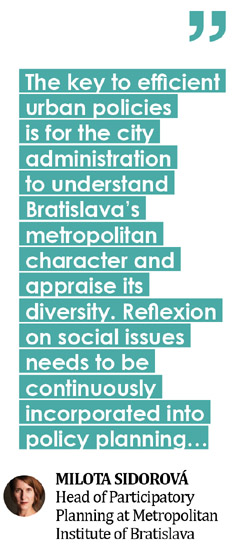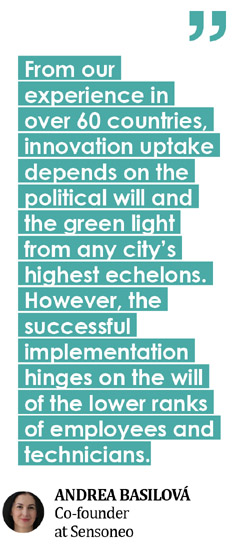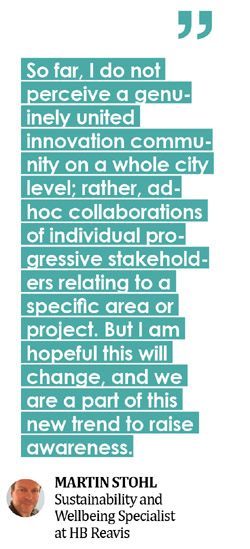The urban dilemma
Compared to other innovation communities, the stakeholders and their success in addressing the arising urban challenges naturally depend on the fixed physical and institutional framework of a particular city or a region. Cities and their institutions can remain conservative and reactive to other actors or become an active coordinator of urban activists, innovators, or entrepreneurs. The latter approach can result in a more self-aware, organized, and goal-unified grouping of stakeholders who jointly resolve urban challenges.
After the 2018 municipal elections, the new administration of Bratislava is moving towards a very active role, setting several guiding principles manifested through new city institutions. Innovation-related activities were given more attention through the formation of a new role of Chief Innovation Officer. Participatory planning became the primary agenda of a newly established Metropolitan Institute, and data became the domain of the Data Analytics and Policy Department.
Compared to commercial markets, driving a significant change in cities almost always requires a top-down approach. Therefore, these activities and principles like open data, participatory design, or the city as an innovation laboratory need to be pioneered by the city of Bratislava and its newly established institutions. Simultaneously, the city needs to open to external stakeholders and resolve its challenges through a collaborative approach – with active citizens, developers, or innovators.

The community around the urban challenges can be very diverse but we observe increased interest and interaction among stakeholders like startups, corporates, students, or citizens in topics related to city resilience, climate change, or transport.
The changing climate nad social landscape and their impact on the quality of life
Mapping of the vulnerable areas of the city is the first step on the path to resilience. The recently published Atlas of the Vulnerability identified heavy precipitation and extreme heat waves as the two main climate change effects that place population, natural environment, and structures at risk. The increased temperatures are already manifested by an increase of 2°C since 1950. Heatwaves affect energy demand for the buildings’ cooling and physiologically stress especially young children, the sick and elderly.
The city already suffers from the heat island effect with temperatures reaching above 40°C, not limited to the industrial areas. Heavy precipitation and thunderstorms due to heatwaves lead to direct material damages. With increasing extremes and changes in the weather, the population exposed to the consequences of these episodes may become dissatisfied with their life in the city.
According to the data analyzed by the Metropolitan Institute of Bratislava, in addition to the environmental challenges, the city is also facing increasing inequality, with several demographic groups being more vulnerable to the intensifying climate changes. Bratislava and its metropolitan area are growing, while many do not register for permanent residency, leading to lower local taxes being collected and placing the city services under pressure in terms of funding and capacity.

Despite the influx of new inhabitants,Bratislava is getting older, from 18,5% of the population over 65 years in 2019 to the projected 29,8% of seniors in 2050. The social disparity between the highest and lowest income neighborhoods in terms of median incomes is growing.
Unique urban project of Nová Cvernovka
Collaboration among stakeholders from the private, public, and academic spheres is most developed in the grassroots project of Nová Cvernovka. Having started as an artistic community seeking low rent ateliers, the project is now generating a snowball effect as it plays a major role in pushing the concept of a ‘sustainability district’ by becoming the urban Eco center for innovation testing.
The former high school area has been rented to the team by the Bratislava self-governing region for 25 years, and the founders secured a bank loan for the remodel and development. The building has been reconstructed using innovative approaches developed by architects, technicians, locally residing startups, and scientists from the Slovak Academy of Sciences, under the scrutiny of Nová Cvernovka’s Ekoboard.
The goal is to make the building smart by combining new technologies, including recycling and reusing of building waste material, and well-known approaches such as composting, community gardening, or water retention techniques. Its founder Šymon Kliman further proclaims the wish to develop a collaborative platform of artists and scientists to generate innovation and support creative industries, which he considers the backbone of the future (and current) economy of the city.
New business district inspired by sustainability
Another line of collaboration development is that of an enlightened developer, such as the company HB Reavis, also active in the UK, transplanting a collaborative approach and sustainable technology in the Nové Nivy neighborhood development. Involvement of regulatory stakeholders such as departments of transportation is required; however, reaching out to neighbors, cyclists or disabled groups goes beyond Slovak cities’ standard.
In terms of design with inclusive and sustainable characteristics, the project reflects on cycling infrastructure, heat management, air quality, biodiversity, or measures to withstand shocks such as torrential rains.
 Quality of collaboration depends on individuals
Quality of collaboration depends on individuals
Existing collaborations are linked through strong individuals. Interactions mapping shows repeating names, people flowing through startups, city administration, NGOs, and corporates. Individuals connect on several platforms, such as the Sustainability lead of HB Reavis co-founding a green building association and the city’s Chief Architect. There, representatives of the city, the developers, and the community mingle and push on concrete measures, creating a steppingstone for a cluster of organizations.
Currently, sustainability is driven by individuals that take this agenda and push it forward, demanding ambition. New thinking, new approaches require commitment from the top but mostly understanding from the day-to-day operations staff. The right people in the right places enable innovation uptake. A city-wide pilot in smart waste management using the technology of the Slovak startup Sensoneo has been enabled through a shared understanding of the issues and of the benefits and only made possible through the willingness to change the status quo and test new waters, which is not a given.
Aware of the budgetary, regulatory, and personnel constraints, the city understands its role in terms of enabling, supporting, and nurturing innovation. This approach rests on three pillars. Firstly, creating a city laboratory mindset to pilot solutions. Secondly, generating as much data as possible to design efficient policies. Thirdly, taking up the best international practices and partaking in international projects.
So far, the strategy is on track: a portfolio of initiatives is ready to be coopted by citizens, and projects like Nová Cvernovka offer the necessary testbed for innovations. The key will be to design mechanisms to scale these innovations to the whole city. Acceleration programs like Challenger offer business support to Greentech and Sustainability-driven startups. The city has, in the spirit of its developing role as an enabler, spearheaded the first Bratislava Climathon, in partnership with the reinsurance company Swiss Re, Civitta, and HubHub, activating experts and employees from all of the city’s offices as well as experts outside of the municipal structures.
 Final thoughts
Final thoughts
The city of Bratislava should continue to create space for courageous actions. The new city administration has found its voice and seemingly a functioning mode of operations under the budgetary, personnel, and practical constraints it is bound by. Therefore, it should continue to connect actors and enable third parties to develop and run courageous projects. The critical task is to remove administrative roadblocks to private and public initiatives that the city supports but would not carry out independently. An open sandbox for technical and social innovations needs to be better communicated and comprehensibly structured.
There are islands of resistance that remain to be converted. Individuals in key positions and entities external to the city, such as the state and its agencies, maintain key decision powers, which they will continue to hold in the future. Especially in the transport area, the conservative rule-makers limit the possible uptake of innovation driving sustainability. The city, given its dominant position and political power, and the other stakeholders, should strengthen their efforts to reform rules such as the Construction Act to enable new approaches. Cities like Ljubljana offer an inspiration: boldly implement incremental changes to build a large mosaic, which would have never been accepted initially as a whole.
The increasing inequality among the neighborhoods in Bratislava is bound to be exacerbated by the climate change effects. Forming a vibrant and active innovation community needs to be accompanied by the social aspect. It should fall mostly on the city’s shoulders to be the guardians of equality and control for this quality in other stakeholders’ projects. Connected to the social aspect is the need for awareness building, mostly among the youth, which represents an investment in the popular support for potentially misunderstood resilience measures.
Peter Kolesár, Partner, CIVITTA Slovakia; and AmCham Board member
Martin Veselý, Senior Consultant, CIVITTA Slovakia




Follow us